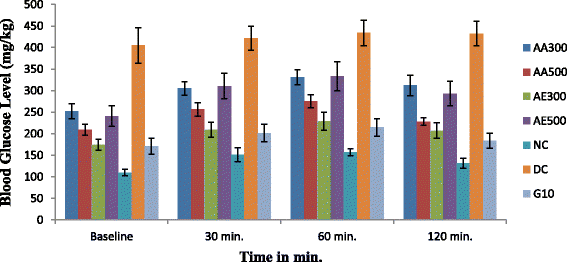Antidiabetic activity and phytochemical screening of extracts of the leaves of Ajuga remota Benth on alloxan-induced diabetic mice
- PMID: 28464813
- PMCID: PMC5414132
- DOI: 10.1186/s12906-017-1757-5
Antidiabetic activity and phytochemical screening of extracts of the leaves of Ajuga remota Benth on alloxan-induced diabetic mice
Abstract
Background: Ajuga remota Benth is traditionally used in Ethiopia for the management of diabetes mellitus. Since this claim has not been investigated scientifically, the aim of this study was to evaluate the antidiabetic effect and phytochemical screening of the aqueous and 70% ethanol extracts on alloxan-induced diabetic mice.
Methods: After acute toxicity test, the Swiss albino mice were induced with alloxan to get experimental diabetes animals. The fasting mean blood glucose level before and after treatment for two weeks in normal, diabetic untreated and diabetic mice treated with aqueous and 70% ethanol extracts were performed. Data were statistically evaluated by using Statistical Package for the Social Sciences software version 20. P-value <0.05 was considered statistically significant.
Results: The medium lethal doses (LD50) of both extracts were higher than 5000 mg/kg, indicating the extracts are not toxic under the observable condition. Aqueous extracts of A.remota (300 mg/kg and 500 mg/kg body weight) reduced elevated blood glucose levels by 27.83 ± 2.96% and 38.98 ± 0.67% (P < 0.0001), respectively while the 70% ethanol extract caused a reduction of 27.94 ± 1.92% (300 mg/kg) & 28.26 ± 1.82% (500 mg/kg). Treatment with the antidiabetic drug, Glibenclamide (10 mg/kg body weight) lowered blood glucose level by 51.06% (p < 0.05). Phytochemical screening of both extracts indicated the presence of phenolic compounds, flavonoids, saponins, tannins, and steroids, which might contribute to the antidiabetic activity. The extracts, however, did not contain alkaloids and anthraquinones.
Conclusion: The aqueous extract (500 mg/kg) showed the highest percentage reduction in blood glucose levels and the ability of A. remota extracts in reducing blood glucose levels presumably due to the presence of antioxidant constituents such as flavonoids. The effect of the extract supported the traditional claim of the plant.
Keywords: Ajuga Remota; Antidiabetic activity; Blood glucose level; Diabetes mellitus; Glibenclamide; Phytochemical screening.
Figures


References
-
- International Diabetes Federation (IDF) Diabetes Atlas-7th Edition, 2015. http://www.diabetesatlas.org/resources/2015-atlas.html or (http://www.oedg.at/pdf/1606_IDF_Atlas_2015_UK.pdf).
-
- Rubin R, Strayer DS, Rubin E. Rubin's Pathology: Clinicopathologic Foundations of Medicine, 6th ed. Philadelphia: Lippincott Williams & Wilkins, 2012; 1081–1098.
-
- International Diabetes Federation (IDF) Diabetes Atlas-5th Edition, 2012 http://www.indiaenvironmentportal.org.in/files/file/diabetes%20atlas%202...
MeSH terms
Substances
LinkOut - more resources
Full Text Sources
Other Literature Sources
Medical
Research Materials

